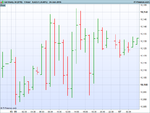These are the sort of remarks that are made -- repeatedly -- by those who don't understand how and why price moves.
First, you yourself are "overthinking" the whole thing as evidenced by all the baggage you've carried into your view.
Second, trading is not a zero-sum game unless you are trading in a closed system.
Third, price does not move randomly. Those who don't understand how and why it moves resort to the randomness argument rather than work their way through and puzzle it out.
Fourth, R:R ratios are pointless as no one has any idea what the reward will be or even might be for any given trade. The only side to this equation that one has any control over is risk.
Fifth, it is possible for transactions to be equal and continguous, but only for a second or two, and rarely. Observe a tick chart sometime.
If you had been studying the market all this time as opposed to books and websites and wherever else you got your misinformation, you might have done much better. As it stands, it appears that you have only wasted your time, and you'll never get it back.

